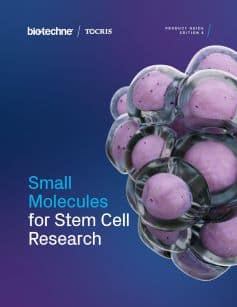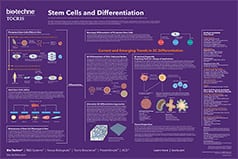Hematopoietic Stem Cells (HSCs)
Hematopoietic Stem Cells (HSCs) are multipotent precursors, that exhibit self-renewal capacity and the ability to regenerate all the different blood and immune cell types. This process, known as hematopoiesis, occurs in adult bone marrow during embryonic development and throughout adulthood. HSCs are used for treating blood related cancers (leukemia, lymphoma), hereditary blood disorders, and to replenish cells lost due to chemotherapy. HSCs are also of great interest for gene therapy.
| Cat. No. | 产品名称/活性 |
|---|---|
| 5619 | N-Acetylcysteine amide |
| Maintains HSC function in culture; also GSH precursor; antioxidant | |
| 3979 | Alexidine dihydrochloride |
| Preserves functional hematopoietic stem cells ex vivo; also inhibitor of PTPMT1 | |
| 3299 | AMD 3100 octahydrochloride |
| Promotes HSCs mobilization and expansion | |
| 3194 | BIO |
| Promotes HSC proliferation; also highly selective GSK-3 inhibitor; acts as Wnt activator | |
| 5051 | BIO 5192 |
| Promotes HSCs and progenitor mobilization; also highly potent and selective inhibitor of integrin α4β1 (VLA-4) | |
| 6047 | BOP |
| Promotes HSCs mobilization; also α9β1/α4β1 integrin inhibitor | |
| 6997 | BOP-JF646 |
| Red fluorescent dual α9β1/α4β1 integrin inhibitor comprising BOP conjugated to Janelia Fluor® 646; fluorogenic; photostable | |
| 7153 | BRD 0539 |
| Cell permeable and reversible Cas9 inhibitor | |
| 1231 | Brefeldin A |
| Enhances CRISPR-mediated HDR efficiency; also disrupts protein translocation to Golgi | |
| 5050 | CASIN |
| Induces HSC mobilization; also Cdc42 inhibitor; restores cell polarity | |
| 3858 | CH 223191 |
| Promotes HSCs expansion in vitro; also potent aryl hydrocarbon receptor (AhR) antagonist | |
| 4423 | CHIR 99021 |
| Promotes HSC proliferation; also highly selective GSK-3 inhibitor; acts as Wnt activator | |
| 5331 | CPI 203 |
| Promotes HSC expansion; also BET Bromodomain inhibitor | |
| 5702 | DiD perchlorate |
| HSC stain; also lipophilic fluorescent reagent | |
| 4027 | 16,16-Dimethyl Prostaglandin E2 |
| Regulates HSC development | |
| 6019 | Diprotin A |
| Enhances HSCs viability after harvesting; also dipeptidyl peptidase IV (DPP-IV) inhibitor | |
| 5304 | FICZ |
| Facilitates hPSC to HSC manufacture in vitro; also aryl hydrocarbon receptor (AhR) agonist; | |
| 1508 | GW 9662 |
| Promotes HSCs expansion; increases HSCs engraftment; also PPARγ antagonist | |
| 4840 | KU 0060648 |
| Enhances HDR efficiency and attenuates NHEJ frequency; also dual DNA-PK and PI 3-K inhibitor | |
| 2197 | L-755,507 |
| Enhances CRISPR-mediated HDR efficiency; also very potent and selective β3 partial agonist | |
| 6618 | MB 05032 |
| Promotes HSCs expansion; also potent FBPase inhibitor | |
| 4106 | Nicotinamide |
| Promotes proliferation and expansion of HSC in vitro; also PARP1 inhibitor | |
| 2828 | NU 7026 |
| Improves HDR-mediated editing in HSCs; also selective DNA-PK inhibitor | |
| 2296 | Prostaglandin E2 |
| Promotes HSCs expansion; increases HSCs engraftment | |
| 4181 | Ro 3306 |
| Improves HDR-mediated editing in HSCs; also Cdk1 inhibitor | |
| 1202 | SB 203580 |
| Promotes ex vivo expansion of HSC; also p38 MAPK inhibitor | |
| 1614 | SB 431542 |
| Promotes HSCs proliferation; also inhibitor of TGF-βRI, ALK4 and ALK7 | |
| 5342 | SCR7 pyrazine |
| Enhances HDR efficiency | |
| 3784 | Sildenafil citrate |
| Promotes HSCs mobilization | |
| 7086 | StemRegenin 1 |
| Promotes HSC expansion and engraftment; also aryl hydrocarbon receptor (AhR) antagonist | |
| 5759 | SW 033291 |
| Promotes HSCs expansion and engraftment; also high affinity 15-PGDH inhibitor | |
| 3082 | Tempol |
| Maintains HSC function in culture; also superoxide scavenger; Antioxidant | |
| 3114 | Troglitazone |
| Inhibits cell growth of hematopoietic cell lines; also selective PPARγ agonist; antidiabetic agent | |
| 6002 | Trolox |
| Maintains HSC function in culture; also antioxidant E derivative; Antioxidant | |
| 5493 | XL 413 hydrochloride |
| Improves HDR-mediated editing in HSCs; also potent and selective Cdc7 inhibitor |
Hematopoietic stem cells (HSCs) reside in the bone marrow and generate two progenitor cell lineages: myeloid and lymphoid cells. The myeloid cells include erythrocytes, platelets, neutrophils, basophils, eosinophils, monocytes/ macrophages, and dendritic cells. The lymphoid cells comprise natural killer cells, B and T lymphocytes.

Figure 1: Model of the hematopoietic hierarchy. HSCs have the potential to both self-renew and differentiate. Multipotent progenitors give rise to all hematopoietic cell types.
Adapted from Zhang et al. (2019) The physical microenvironment of hematopoietic stem cells and its emerging roles in engineering applications. Stem Cell Research & Therapy 10, 327. PMID: 31744536
Control of Hematopoietic Stem Cells
The HSC microenvironment in the bone marrow, called the niche, controls the balance between differentiation and self-renewal to ensure hematopoietic homeostasis. This process is highly regulated by the presence of transcription factors and cytokines. Manipulating individual cytokines is a possible approach to stimulate the regeneration and recovery of hematopoiesis following chemotherapy. The cytokine TGFβ for example, plays an important role in the quiescence and self-renewal of HSCs and can affect most cell types throughout the hematopoietic process.
Hematopoietic Stem Cell Transplantation
Hematopoietic stem cell transplantation (HSCT) for the treatment of blood and immune system disorders, such as leukemia and multiple myeloma, is the focus of considerable biomedical and clinical research. HSCs can be collected from adult bone marrow and umbilical cord blood, but mainly from peripheral blood. The aim of HSCT is to replenish the HSCs in the bone marrow following patient chemotherapy.
Hematopoietic Stem Cell Gene Therapy
Gene therapy using hematopoietic stem and progenitor cells (HSPCs) is a therapeutic approach for the treatment of multiple genetic and inherited disorders. HSPCs collected from bone marrow can be gene modified ex vivo and transferred back to the patient. There are two main approaches used for the gene modification of patient HSCs, integrating viral vectors (lentiviruses or gamma-retroviruses) and gene editing. The latter presents the advantage of a therapeutic gene site-specific insertion within the target genome of the HSCs. Clustered regularly interspaced short palindromic repeats (CRISPR) enables precise ex vivo gene editing in HSPCs. Small molecules can improve gene editing in HSPCs such as some inhibitors of non-homologous end-joining (NHEJ) proteins (NU7441, NU7026, SCR7 pyrazine), or some modulators of the cell cycle (Nocodazol, Ro 3306, XL 413 hydrochloride).

Figure 2: Hematopoietic stem cell gene therapy (a) General overview of the gene-modified patient cells approaches: (1) Isolation of CD34+ hematopoietic stem and progenitor cells (HSPCs) from bone marrow harvests or mobilized peripheral blood cell collections; (2) Ex vivo HSPCs gene modification; (3) Transplantation of the gene-modified patient cells (c) Genome editing using the clustered regularly interspaced palindrome repeat (CRISPR)-associated (Cas) platform. Abbreviations: crRNA, CRISPR RNA; DSBs, double-stranded breaks; HDR, homology directed repair; NHEJ, non-homologous end-joining; PAM, protospacer-adjacent motif; sgRNA, single guide RNA; tracrRNA, trans-activating CRISPR RNA.
Adapted from Salisbury-Ruf and Larochelle (2021) Advances and Obstacles in Homology-Mediated Gene Editing of Hematopoietic Stem Cells. J Clin Med 10, 513. PMID: 33535527
Visit our sister brand R&D Systems for a comprehensive list of Hematopoietic Stem Cell Products including premium quality antibodies, small molecules for HSCs differentiation, expansion media, HSC transcription factors and regulators, multicolor flow cytometry kit and methylcellulose media for colony forming cell assays.
Literature for Hematopoietic Stem Cells (HSCs)
Tocris offers the following scientific literature for Hematopoietic Stem Cells (HSCs) to showcase our products. We invite you to request* your copy today!
*Please note that Tocris will only send literature to established scientific business / institute addresses.
Stem Cells Scientific Review
Written by Kirsty E. Clarke, Victoria B. Christie, Andy Whiting and Stefan A. Przyborski, this review provides an overview of the use of small molecules in the control of stem cell growth and differentiation. Key signaling pathways are highlighted, and the regulation of ES cell self-renewal and somatic cell reprogramming is discussed. Compounds available from Tocris are listed.
Stem Cell Workflow Poster
Stem cells have potential as a source of cells and tissues for research and treatment of disease. This poster summarizes some key protocols demonstrating the use of small molecules across the stem cell workflow, from reprogramming, through self-renewal, storage and differentiation to verification. Advantages of using small molecules are also highlighted.




